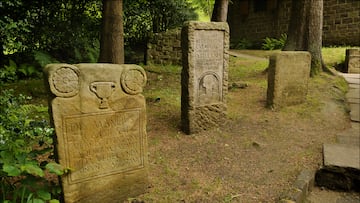How a 1,900-year-old Roman soldier’s gravestone ended up in the backyard of a house in New Orleans
A rectangular stone, engraved with Latin writing, was discovered when a married couple were tending their garden.


A married couple in New Orleans made a astonishing discovery while tending their garden earlier this year, uncovering an archaic artifact that dates back nearly 2,000 years.
The find was made by Daniella Santoro and husband Aaron Lorenz. Santoro, an anthropologist at Tulane University, found a rectangular stone in the back garden and noticed distinctive Latin engraving. Initially she was worried that her discovery meant that the couple’s house was built on top of a cemetery.
However when she contact the Preservation Resource Center of New Orleans (PRC) the true origins of the stone were uncovered. D. Ryan Gray of the University of New Orleans used the stone’s Latin inscription and shared images with other in the archaeology world and was able to make an important link.
“They quickly came independently to the same conclusion,” Gray told Smithsonian magazine. “Not only was this a Roman funerary inscription for a sailor named Sextus Congenius Verus, but the circa second-century inscription had been reported before.”
The report in question offered a rough translation of the stone’s text: “To the Spirits of the Dead for Sextus Congenius Verus, soldier of the praetorian fleet Misenensis, from the tribe (natio) of the Bessi [i.e., a Thracian], (who) lived 42 years (and) served 22 in the military, on the [trireme] Asclepius. Atilius Carus and Vettius Longinus, his heirs, made (this) for him well deserving.”
Essentially, researchers believe that the gravestone was that of a Praetorian soldier named Sextus Congenius Verus, who had spent 22 years on a Roman warship named Asclepius before his death. The stone is thought to have been reported missing from the National Archaeological Museum of Civitavecchia, around 40 miles form Rome.
The area was bombed heavily during World War II and much of the collection was destroyed. However a lot of cultural artifacts like this gravestone were stolen by American servicemen during World War II and taken back to the States. Recently two long-lost paintings by Dutch artist Ambrosius Bosschaert were unearthed at auction in the US and it is believed that they were taken by American soldiers.
For now, researchers haven’t been able to work out exactly who brought the gravestone to New Orleans after the war. But it will now return to its rightful home in Italy.
Related stories
Get your game on! Whether you’re into NFL touchdowns, NBA buzzer-beaters, world-class soccer goals, or MLB home runs, our app has it all.
Dive into live coverage, expert insights, breaking news, exclusive videos, and more – plus, stay updated on the latest in current affairs and entertainment. Download now for all-access coverage, right at your fingertips – anytime, anywhere.


Complete your personal details to comment